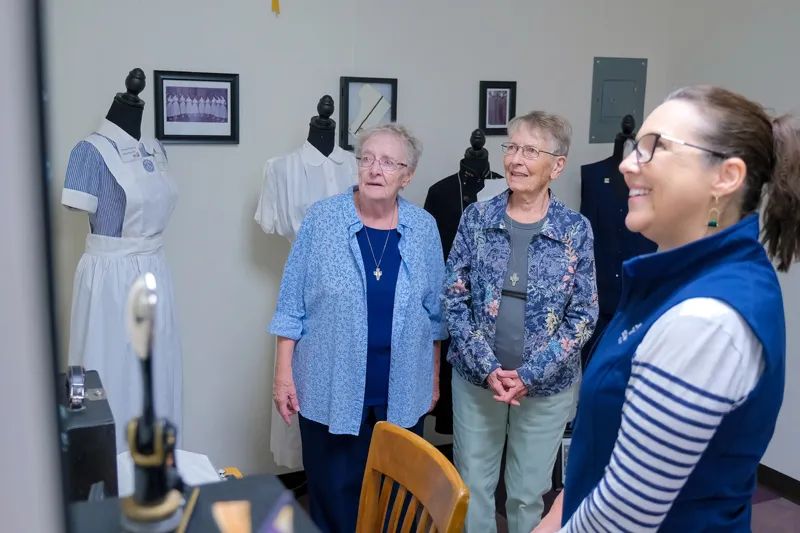
125 Years of Caring
Only a few remain of the religious order that helped found St. Vincent Healthcare
On any given day, you might find Sister Bernadette Helfert or Sister Eileen Hurley at the Guest Services desk at St. Vincent Healthcare. As one of the hospital’s volunteers, they might be one of the first faces to help welcome a person into the hospital. Or they might take a little trip to help deliver flowers to brighten up a patient’s room.
Spotting one of these Sisters of Charity might not be easy. They traded their religious attire for street clothes years ago. While the habits are gone, the history still runs deep with these women. They are two of only four members the order left here that helped found the Billings hospital.
On Aug. 7, Saint Vincent Healthcare helped ring in 125 years of service to the community. Much has changed since that cornerstone was laid, thanks to the direction of the Sisters of Charity of Leavenworth.
In the early days, nuns not only led the fledging medical center, but they also they raised funds to keep it running and nursed the ailing patients. Sisters also “performed a great deal of back-breaking labor,” author Sue Hart wrote in “The Call to Care,” a book which detailed the hospital’s first 110 years. They cleared away brush and debris, gardened, raised poultry outside and inside kept everything in tip-top shape.
“No lay help was even considered, as resources were too meager to afford even a comfortable living for the Sisters,” Hart adds.
These days, the remaining sisters serve as volunteers. All the other roles, from administrators to the medical and support staff, are filled by lay people. What hasn’t changed, Helfert says, is the focus on faith.
“The ministry of Jesus will always be there, and that’s what will remain,” she says.
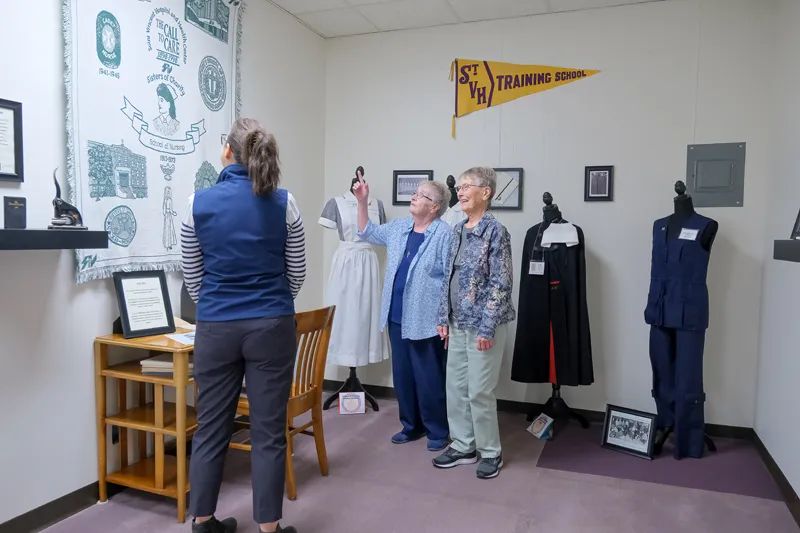
From the beginning, St. Vincent Hospital, with its Catholic core, had an ecumenical flavor, Hart wrote. Dr. Henry Chapple, a physician who was an Episcopalian, teamed up with Father Francis Van Clarenbeck, a Catholic priest, in 1897, to request the Sisters of Charity consider constructing a hospital in Billings.
The property for the original building, built along what is now Division Street, between Broadwater and Wyoming avenues where Central High School now sits, was donated by two Protestants and a Catholic.
“And certainly, as far as the Sisters were concerned, St. Vincent Hospital was established to serve all of the Billings community, as well as the surrounding region, without regard to race, religion, color or creed,” Hart said.
Tracy Neary, vice president of mission integration for St. Vincent, tells an amusing story about how the initial location for the hospital was chosen. The town of Billings grew up around the tracks laid by the Northern Pacific Railroad. At first, the hospital was to be located south of the tracks.
“However, Mass was on the north side of the tracks,” Neary says. “So, part of what weighed into the decision was making sure the sisters wouldn’t be held up by a train and be late to Mass.”
Much of the hospital’s history has been preserved in a newly completed archive on the first floor of Marillac Hall, near the corner of North 30th Street and 12th Avenue North, where the hospital was relocated in the 1920s. A large photographic mural on one wall of the room depicts people and places central to the origins of the sisters’ order and the hospital’s history.
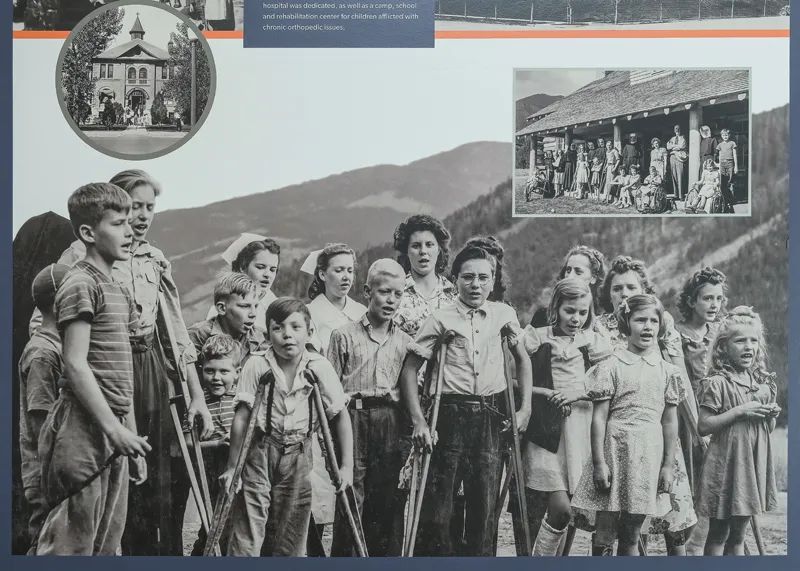
Neary, during a, informal tour of the archive, opened a drawer that held another piece of the hospital’s past, a tiny crutch and brace, used circa 1916 for treatment during the devastating polio epidemic. The archive will be available to the public during periodic open houses over the next year.
Marillac Hall was opened in 1947 to house both the sisters and a nursing school. One who remembers that time is Sister Jean Lind, who completed several stints at the Billings hospital. Now 90 years old and living at the Mother House in Kansas, Lind was interviewed via video for the 125-year celebration. A Butte native, Lind, who attended the St. Vincent School of Nursing in Montana in the mid-1950s, put her focus on maternity care.
After she left to earn a master’s degree, she returned to St. Vincent Hospital in 1966 and initially served as an instructor at the nursing school and then as OB supervisor from 1969 to 1972.
“I loved to work in the nursery and in labor and delivery,” she says.
She then served as supervisor of the newly created neonatal intensive care department, from 1972 to 1977. Lind remembers being part of a response team that traveled via fixed-wing aircraft to pick up patients and transport them to St. Vincent. She recalls one particular challenge, when a baby was transported aboard the plane.
“The IV began to freeze in the bottle,” Lind says. “The baby, we had in the incubator, so what do we do? Well, you put the bottle in the incubator, but you have to stop and think for a minute, well let’s see, how are we gonna do this?”
Hurley, 81, also a native of Butte and member of the order for more than 60 years, can still be found these days at the hospital staying active beyond her weekly stint at Guest Services. She is also one of two sisters who serve on the hospital board, along with Sister Judith Jackson, and as a member of the Quality and Patient Safety Committee for the three Montana hospitals.
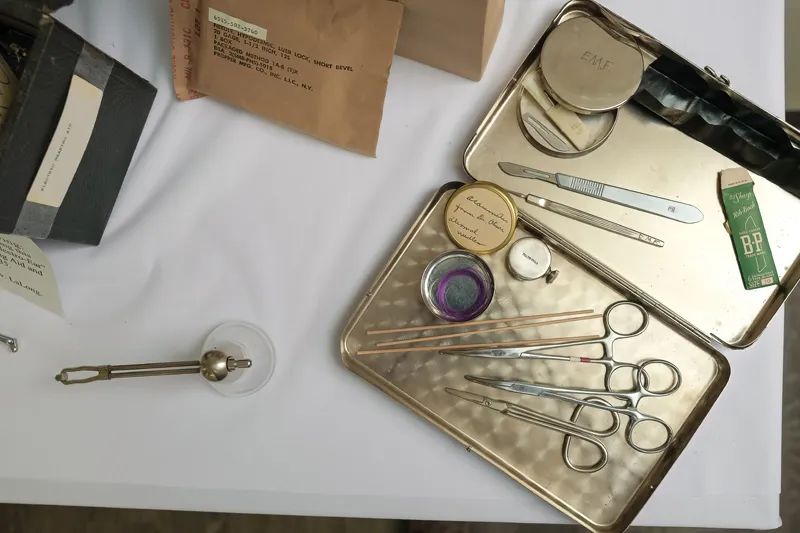
Hurley, one of the last of the sisters in hospital leadership, served in multiple roles in different locations over the years, ranging from teacher to parish administrator to director of lay ministry for the Diocese of Great Falls-Billings and part of the leadership of SCL Health. It wasn’t until 1990 that she came to Billings to stay.
“I knew people here,” she says. “And I could use some of my gifts, even in my retirement years.”
She’s observed the change in leadership over the course of time.
“For a long time, there were only sisters as board members,” Hurley says. “And then at some point that began to transition.”
That changeover also occurred among the administration of St. Vincent and the other two SCL hospitals in Montana, St. James in Butte and Holy Rosary in Miles City. Like a relay race, the sisters began passing the baton onto a new generation of leaders and health care providers.
“The whole thing is we plant the seed, but we’re not necessarily going to see it all grow,” Hurley says.
Helfert, who was born and raised in Helena, has also worn many hats in her nearly 65 years of ministry. The list includes elementary teacher and principal, member of the order’s personnel board and its leadership council, parish administrator and mission director.
In 1994, she was asked to assume the role of regional vice president for mission integration for Montana’s three SCL hospitals.
“As the sisters left, there was a gap in who was going to focus intentionally on the values,” she says. “It’s the spirituality of what we do, more than just care, it’s deeper. It’s sharing in the ministry of God’s work here on earth.”
Helfert paused, tears in her eyes, when asked what that looks like in the hospital.
“Sometimes people say to me ‘I can tell the difference when I walk into the hospital, I feel the difference,’” she says. “It is the spirit of the healthcare workers. They are so caring.”
It stems all the way back to Mother Xavier Ross, who founded the SCL order, Helfert says. From the start, the founder taught young novices that when somebody walks in the hospital “they are the face of Christ, and you treat everybody the same.”
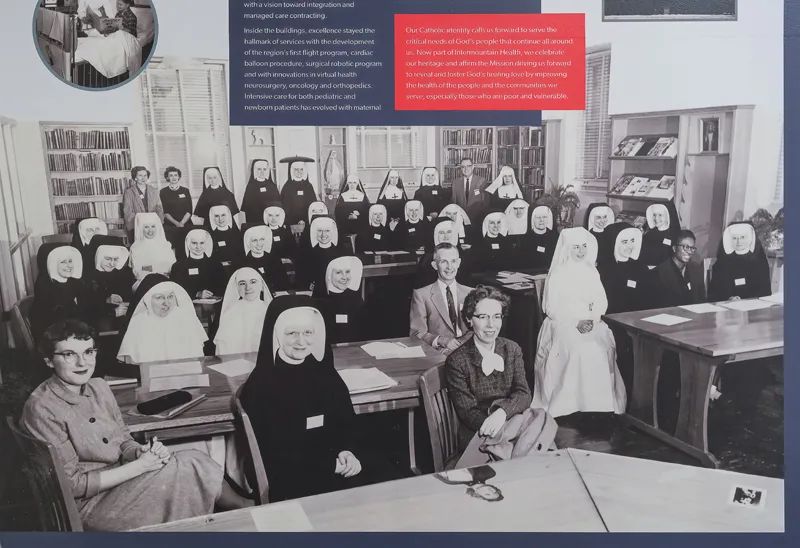
Helfert sees the era of the sisters at St. Vincent coming to an end.
“Now there are four of us, and we’re all in our 80s,” she says.
The baton is being handed to people like Neary, who has worked at St. Vincent since 2000 and now has the responsibility to encourage caregivers to serve in ways that demonstrate to patients “the embodiment of Christ the healer.”
“We want people to find healing and hope in all their encounters with us, whether they’re patients, community members or coworkers,” Neary says. “How do we bring alive that Gospel vision of hope?”
Another recent change the hospital has seen is the 2022 merger of the St. Vincent’s umbrella organization, SCL Health, with Intermountain Health. When SCL Health leadership, including members of the order, considered the merger, a key question was whether such a move would allow it to maintain its Catholic identity. Only knowing that would continue allowed the merger to go forward, Neary says.
It will permit St. Vincent Healthcare to grow and change in some ways, to better meet the needs of its patients. That includes the budding plans to build a replacement hospital on North 27t Street.
But the hospital’s name will remain the same, she says, and so will its values, which permeate the hospital.
“People can’t always name it, sometimes it feels a little intangible,” Neary says. “It’s the intentionality of caring for the whole person – you’re more than a diagnosis, you’re a whole rich flourishing human being and we want to help people find that fullness, that wholeness of body, mind and spirit.”











